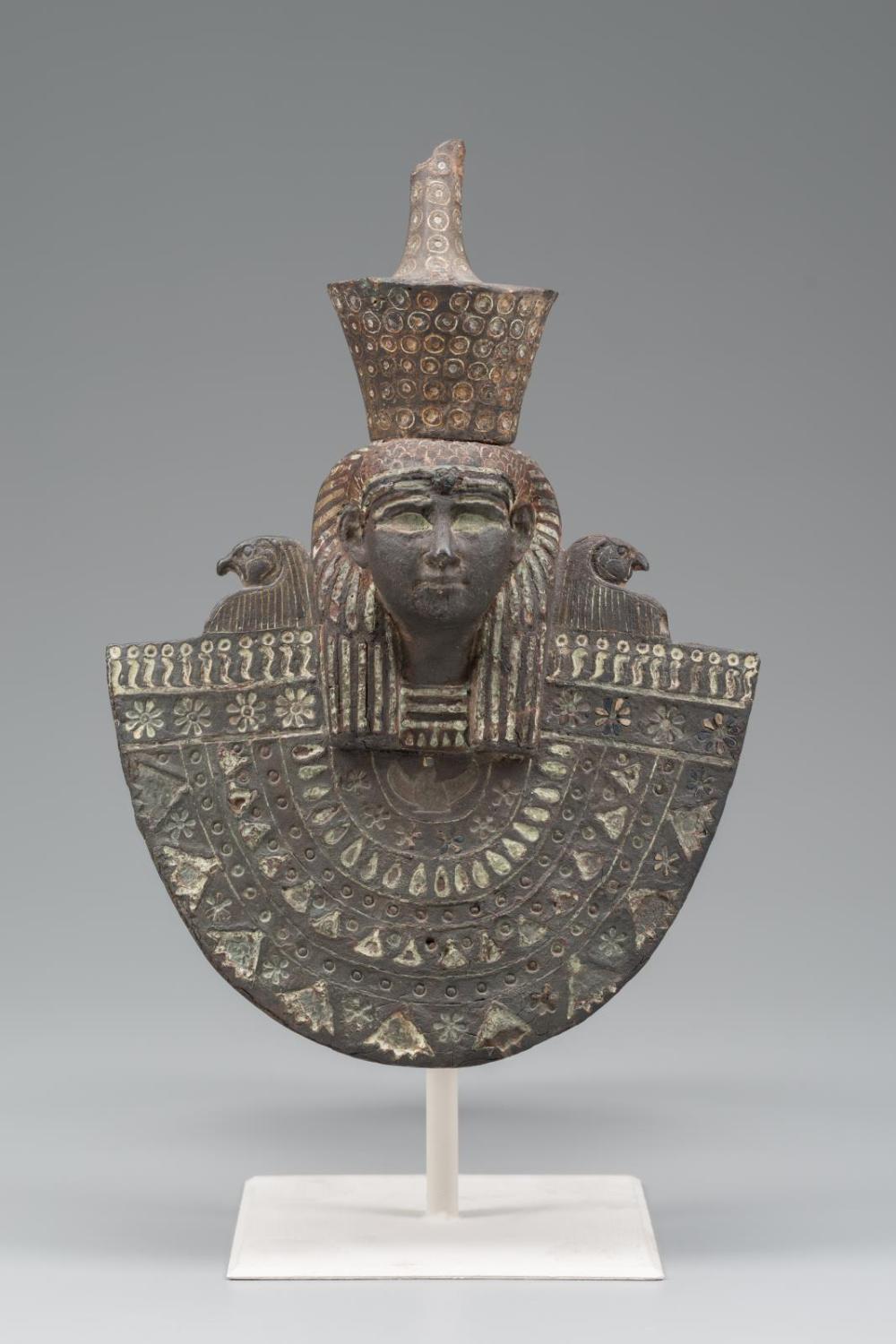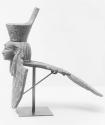Advanced Search
Aegis of Isis
Egyptian
Third Intermediate Period, Dynasty 22
945–712 B.C.
Medium/Technique
Bronze with inlays of electrum, silver, and bronze
Dimensions
Height x width x depth: 27.5 x 19.2 x 29.3 cm (10 13/16 x 7 9/16 x 11 9/16 in.);
Credit Line
Adelia Cotton Williams Fund
Accession Number31.195
NOT ON VIEW
CollectionsAncient Egypt, Nubia and the Near East
ClassificationsReligious and cult objects
DescriptionEarly Egyptologists with a Classical background often drew on vocabulary from Greek mythology to describe Egyptian antiquities for which a suitable term was lacking. They borrowed the word aegis, which refers to the shield or breastplate of Athena, for religious or cult objects shaped like a broadcollar surmounted by the head of a deity. Evidently such a composition reminded them of images from Greek vase painting of Athena with the head of Medusa on her breastplate, serpents swirling around the perimeter.
This particularly large and ornate aegis represents the goddess Isis. She wears the crown of Upper Egypt over a vulture headdress and a broadcollar with falcon-head terminals and a frieze of uraei along the top. The combination of different metal alloys for contrast was a specialty of the period and serves to point out the intricate patterns of the collar and crown.
In real life such a heavy collar would have required a counterpoise, called a menat, to keep it in place. Such a counterpoise, heavily decorated, is attached to the back of this aegis by a hinge. The square scene at the top of the menat shows Isis suckling Horus. In Egyptian mythology, Isis took her newborn son Horus to the Delta marshes to hide him from his evil uncle Seth. There she protected him by her magic from snakes and scorpions. The round scene below shows Horus again, represented as a falcon in a papyrus grove flanked by the protective goddesses of the south (the vulture) and the north (the cobra). In both scenes Horus represents the king as recipient of divine sustenance and protection. Such elaborate mythological compositions were popular in Dynasty 22, when the technique of inlaid bronze was also at its height.
In Egyptian art aegises appear as prow orna-ments on sacred boats and as finials on the top of poles carried in religious processions. They also occur as amulets and on finger rings, or they can be held in the hands of bronze statuettes of goddesses. It is not known how this particular aegis was used. There is no convenient way to hold it. It is perhaps best regarded as a votive offering placed in a temple.
This particularly large and ornate aegis represents the goddess Isis. She wears the crown of Upper Egypt over a vulture headdress and a broadcollar with falcon-head terminals and a frieze of uraei along the top. The combination of different metal alloys for contrast was a specialty of the period and serves to point out the intricate patterns of the collar and crown.
In real life such a heavy collar would have required a counterpoise, called a menat, to keep it in place. Such a counterpoise, heavily decorated, is attached to the back of this aegis by a hinge. The square scene at the top of the menat shows Isis suckling Horus. In Egyptian mythology, Isis took her newborn son Horus to the Delta marshes to hide him from his evil uncle Seth. There she protected him by her magic from snakes and scorpions. The round scene below shows Horus again, represented as a falcon in a papyrus grove flanked by the protective goddesses of the south (the vulture) and the north (the cobra). In both scenes Horus represents the king as recipient of divine sustenance and protection. Such elaborate mythological compositions were popular in Dynasty 22, when the technique of inlaid bronze was also at its height.
In Egyptian art aegises appear as prow orna-ments on sacred boats and as finials on the top of poles carried in religious processions. They also occur as amulets and on finger rings, or they can be held in the hands of bronze statuettes of goddesses. It is not known how this particular aegis was used. There is no convenient way to hold it. It is perhaps best regarded as a votive offering placed in a temple.
ProvenanceBy 1931: Ellen Day Hale collection, Washington, D.C.; 1931: purchased by the MFA from Ellen Day Hale.
(Accession Date: April 1, 1931)
(Accession Date: April 1, 1931)





